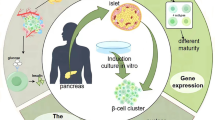We studied antidiabetic effects and cytoprotective activity of two lithium salts (lithium chloride and lithium carbonate) on the model of streptozotocin-induced diabetes mellitus type 2 in Wistar rats. Using the method of β-cells detection with antibodies to insulin, we demonstrated that streptozotocin reduced the number of β-cells and impaired their morphological structure. Both lithium preparations administered to diabetic animals for 28 days in doses of 10 and 8.9 mg/kg, respectively, attenuated the damaging effect of streptozotocin. This cytoprotective effect of lithium salts manifested in weakening of hyperglycemia, polyphagia, polydipsia, and weight loss. A satisfactory correlation between the morphometric data and blood glucose levels was revealed. The mechanisms of the multitarget action of lithium salts are discussed.
Similar content being viewed by others
References
Ostrovskaya RU, Ivanov SV, Ozerova IV. The Concept of Similarity between Pancreatic β-cells and Neurons: Pharmacological Aspects. Eksp. Klin. Farmakol. 2017;80(9):20-27. Russian.
Torshin IYu, Gromova OA. Expert Data Analysis in Molecular Pharmacology. Moscow, 2012. Russian.
Aminzadeh A, Dehpour AR, Safa M, Mirzamohammadi S, Sharifi AM. Investigating the protective effect of lithium against high glucose-induced neurotoxicity in PC12 cells: involvements of ROS, JNK and P38 MAPKs, and apoptotic mitochondria pathway. Cell. Mol. Neurobiol. 2014;34(8):1143-1150.
Ali TK, Al-Gayyar MM, Matragoon S, Pillai BA, Abdelsaid MA, Nussbaum JJ, El-Remessy AB. Diabetes-induced peroxynitrite impairs the balance of pro-nerve growth factor and nerve growth factor, and causes neurovascular injury. Diabetologia. 2011;54(3):657-668.
Behl T, Kotwani A, Kaur I, Goel H. Mechanisms of prolonged lithium therapy-induced nephrogenic diabetes insipidus. Eur. J. Pharmacol. 2015;755:27-33.
Chandrasekar B, Mathur SK, Mukherjee SK. Anti-secretagogue effect of lithium on isolated rat islets of Langerhans. J. Exp. Biol. 1989;27(2):163-165.
Chuang DM, Wang Z, Chiu C.. GSK-3 as a target for lithium-induced neuroprotection against excitotoxicity in neuronal cultures and animal models of ischemic stroke. Front. Mol. Neurosci. 2011;4:15. doi: https://doi.org/10.3389/fnmol.2011.00015.
de la Monte SM. Insulin resistance and neurodegeneration: progress towards the development of new therapeutics for Alzheimer’s Disease. Drugs. 2017;77(1):47-65.
Dwivedi T, Zhang H. Lithium-induced neuroprotection is associated with epigenetic modification of specific BDNF gene promoter and altered expression of apoptotic-regulatory proteins. Front. Neurosci. 2015;8:457. doi: https://doi.org/10.3389/fnins.2014.00457.
Feng ZC, Donnelly L, Li J, Krishnamurthy M, Riopel M, Wang R. Inhibition of Gsk3b activity improves b-cell function in c-KitWv/+ male mice. Lab. Invest. 2012;92(4):543-555.
Forlenza OV, Aprahamian I, de Paula VJ, Hajek T. Lithium, a therapy for AD: current evidence from clinical trials of neurodegenerative disorders. Curr. Alzheimer Res. 2016;13(8):879-886.
Le Douarin NM. On the origin of pancreatic endocrine cells. Cell. 1988;53(2):169-171.
Nikoulina SE, Ciaraldi TP, Mudaliar S, Mohideen P, Carter L, Henry RR. Potential role of glycogen synthase kinase-3 in skeletal muscle insulin resistance of type 2 diabetes. Diabetes. 2000;49(2):263-271.
Ostrovskaya RU, Zolotov NN, Ozerova IV, Ivanova EA, Kapitsa IG, Taraban KV, Michunskaya AM, Voronina TA, Gudasheva TA, Seredenin SB. Noopept normalizes parameters of the incretin system in rats with experimental diabetes. Bull. Exp. Biol. Med. 2014;157(3):344-349.
Woodgett JR. Physiological roles of glycogen synthase kinase-3: potential as a therapeutic target for diabetes and other disorders. Curr Drug Targets Immune Endocr. Metabol. Disord. 2003;3(4):281-290.
Author information
Authors and Affiliations
Corresponding author
Additional information
Translated from Byulleten’ Eksperimental’noi Biologii i Meditsiny, Vol. 165, No. 6, pp. 716-721, June, 2018
Rights and permissions
About this article
Cite this article
Ostrovskaya, R.U., Ivanov, S.V. & Durnev, A.D. Neuroprotective Lithium Salts Protect Pancreatic β-Сells from Damage. Bull Exp Biol Med 165, 758–762 (2018). https://doi.org/10.1007/s10517-018-4259-7
Received:
Published:
Issue Date:
DOI: https://doi.org/10.1007/s10517-018-4259-7




